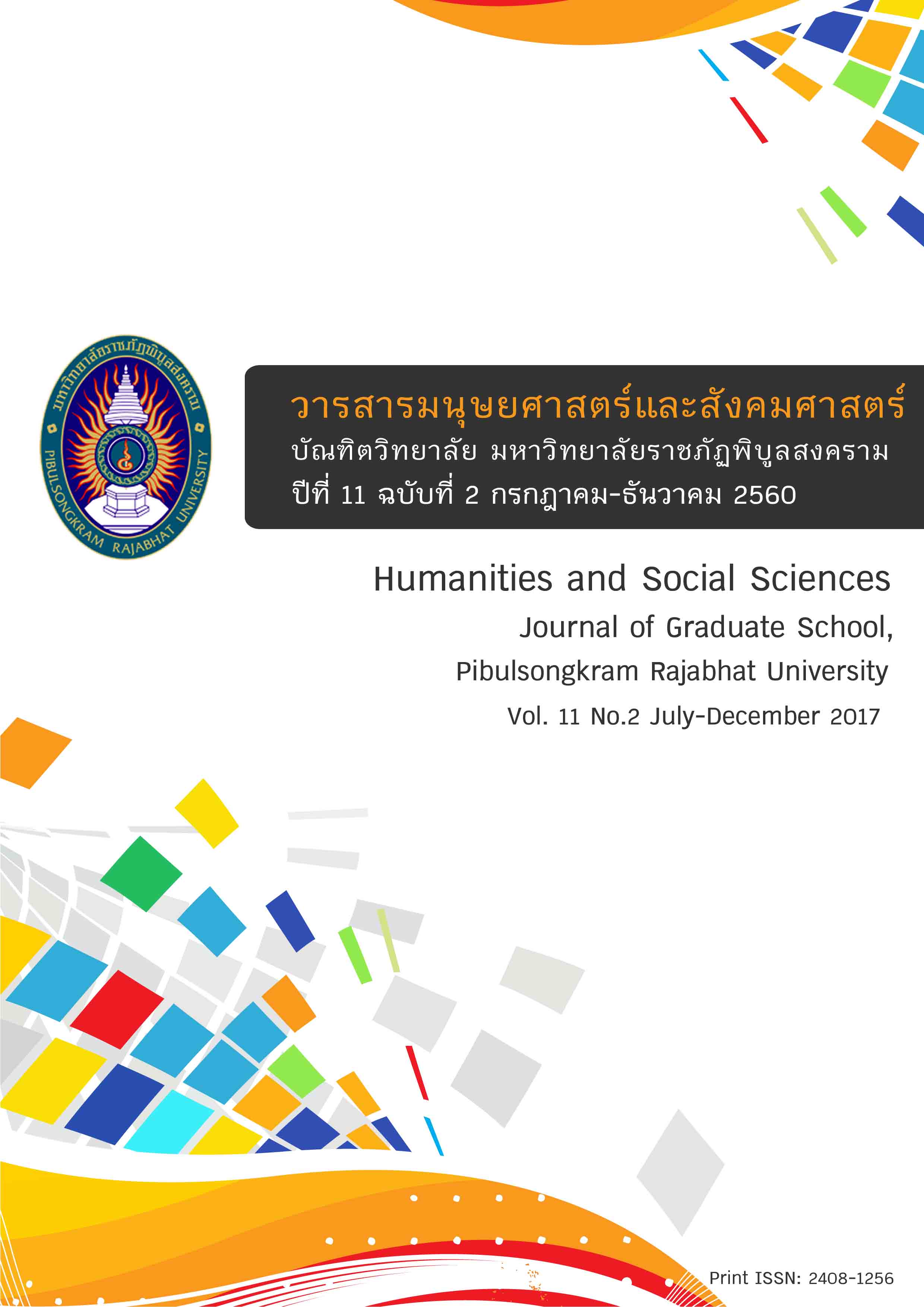A Development of Learning Activities by Using Science, Technology, Society and Environment Approach to Promote Problem Solving Ability and Environmental Consciousness on Topic “Resource and Environment Conservation” for Grade 9 Students
Keywords:
Learning activities to Science-Technology-Society and Environment Approach, Problem Solving Ability, Environmental ConsciousnessAbstract
การวิจัยครั้งนี้มีวัตถุประสงค์เพื่อ 1) สร้างและประเมินประสิทธิภาพของกิจกรรมการเรียนรู้ตามแนวคิดวิทยาศาสตร์ เทคโนโลยี สังคม และสิ่งแวดล้อม (STSE) ตามเกณฑ์ 75/75 2) ศึกษาผลการใช้กิจกรรมการเรียนรู้ตามแนวคิด STSE โดย (2.1) เปรียบเทียบความสามารถในการคิดแก้ปัญหาก่อนเรียนและหลังเรียน (2.2) ศึกษาจิตสำนึกต่อสิ่งแวดล้อม (2.3) ศึกษาผลการจัดกิจกรรมการเรียนรู้ตามแนวคิด STSE ดำเนินการวิจัย 2 ขั้นตอน ดังนี้ ขั้นตอนที่ 1 การสร้างและประเมินประสิทธิภาพของกิจกรรมการเรียนรู้ตามแนวคิด STSE พิจารณาความเหมาะสมของกิจกรรมการเรียนรู้จากผู้เชี่ยวชาญ 5 ท่าน โดยกิจกรรมการเรียนรู้มี 5 ขั้นตอน คือ 1) สร้างแรงจูงใจให้นักเรียนค้นหาข้อมูล 2) ให้อิสระในการค้นคว้าข้อมูล การซักถามและการอภิปราย 3) อภิปรายร่วมกับนักเรียน 4) กระตุ้นให้นักเรียนประยุกต์ใช้ความรู้ไปลงมือปฏิบัติจริง และ 5) การประเมินผล และทดลองใช้กับนักเรียนชั้นมัธยมศึกษาปีที่ 3 โรงเรียนสามง่ามชนูปถัมภ์ สังกัดสำนักงานเขตพื้นที่การศึกษามัธยมศึกษา เขต 41 ปีการศึกษา 2559 จำนวน 3 คน ที่ไม่ใช่กลุ่มตัวอย่าง เพื่อพิจารณาความเหมาะสมของภาษา เนื้อหา เวลาและสื่อการเรียนรู้ แล้วปรับปรุงแก้ไข จากนั้นนำไปทดลองใช้กับนักเรียน จำนวน 9 คน ที่ไม่ใช่กลุ่มตัวอย่าง เพื่อประเมินประสิทธิภาพของกิจกรรมการเรียนรู้ตามเกณฑ์ 75/75 ขั้นตอนที่ 2 ทดลองใช้กิจกรรมการเรียนรู้ตามแนวคิด STSE กลุ่มตัวอย่าง คือ นักเรียนชั้นมัธยมศึกษาปีที่ 3 โรงเรียนสามง่ามชนูปถัมภ์ จำนวน 32 คน ใช้แบบแผนการทดลอง One Group Pretest–Posttest Design เครื่องมือที่ใช้ในการวิจัยประกอบด้วย 1) กิจกรรมการเรียนรู้ตามแนวคิด STSE 2) แบบบันทึกภาคสนาม 3) แบบทดสอบวัดความสามารถในการคิดแก้ปัญหา และ 4) แบบวัดจิตสำนึกต่อสิ่งแวดล้อม วิเคราะห์ข้อมูลด้วยสถิติ ค่าเฉลี่ย ส่วนเบี่ยงเบนมาตรฐาน และค่าที t-test แบบ dependent sample ผลการวิจัยพบว่า 1) กิจกรรมการเรียนรู้ตามแนวคิด STSE ประกอบด้วย 5 ขั้นตอนคือ (1) รุกให้นักเรียนค้นหาข้อมูล (2) ให้อิสรภาพในการค้นคว้า การซักถาม และอภิปราย (3) อภิปรายร่วมกับนักเรียน (4) กระตุ้นให้นักเรียนนำความรู้ไปลงมือปฏิบัติจริง และ (5) การประเมินโดยมีความเหมาะสมในระดับมากที่สุด (= 4.68, S.D. = 0.22) และมีประสิทธิภาพเท่ากับ 80.07/79.78 2) ความสามารถในการคิดแก้ปัญหาของนักเรียนหลังเรียนสูงกว่าก่อนเรียนอย่างมีนัยสำคัญทางสถิติที่ระดับ .01 3) นักเรียนมีจิตสำนึกต่อสิ่งแวดล้อมหลังเรียนด้วยกิจกรรมการเรียนรู้ตามแนวคิด STSE โดยรวมอยู่ในระดับมาก (
= 4.29, S.D. = 0.32) และ 4) นักเรียนเกิดความสามารถในการคิดแก้ปัญหาและจิตสำนึกต่อสิ่งแวดล้อมระหว่างจัดกิจกรรมการเรียนรู้
The purposes of this research were 1) to construct and assess the efficiency of the learning activities by using Science-Technology-Society and Environment approach (STSE) as the criteria of 75/75. 2) to implement and study the result of the learning activities by using STSE approach. 2.1) to compare the problem solving ability of students in pre-test and post-test by using learning activities by using STSE approach. 2.2) to study students’ environmental consciousness through learning activities by using STSE approach. 2.3) to study learning activities by using STSE approach. The study by of 2 steps as followe.
Step 1 : Constructing and assessing the effectiveness of the learning activities by using STSE approach . Five step of learning activity by using STSE approach of 1. Motivation 2. Finding information 3. Discussion 4. Apply knowledge 5. Evaluation. That certified the model by five experts then tries out with 3 students of Grade 9 at Samngam Chanupathum School under the office of the Secondary Educational Service Area 41 in the second semester of academic year 2016, to semester the appropriateness of language, content, time and educational materials. Therefore, After revised the model, it was tried out with 9 students of Grade 9 at Samngam Chanupathum School, to assess the effectiveness with standard criteria of 75/75.
Step 2 : The implementing by using the learning activities by using STSE approach, with 32 students of Grade 9 at Samngam Chanupathum School as sample group. The research design was One Group Pretest – Posttest Design. The tools applied in the research include 1) The learning activity and plan according by using STSE approach. 2) The field notes 3) Problem solving ability test 4) Environmental consciousness evaluation. The data analysis using mean, standard deviation and T-test dependent sample.
The result of the study revealed that learning activity by using STSE approach. 1) Five step of learning activity by using STSE approach of 1. Motivation 2. Finding information 3. Discussion 4. Apply knowledge 5. Evaluation. The result indicate learning activities had appropriated quality with highest level ( = 4.68, S.D. = 0.22) and effectiveness equal 80.07/79.78. 2. Students had higher problem solving ability level than before study at significance level of .01. 3. The evaluation environmental consciousness the student had high evaluation result (
= 4.29, S.D.=0.32) 4) The result during the study according to learning activities, the students Problem solving ability and Environmental consciousness. Students could create scientific questions and answers, and explain the problems by scientific comprehension and using science knowledge to fix the problems. The students’ satisfaction to learn with the learning activities.
Downloads
Published
How to Cite
Issue
Section
License
บทความหรือข้อคิดเห็นใดใดที่ปรากฏในวารสารมนุษยศาสตร์และสังคมศาสตร์ มหาวิทยาลัยราชภัฏพิบูลสงครามเป็นวรรณกรรมของผู้เขียน ซึ่งบรรณาธิการไม่จำเป็นต้องเห็นด้วย บทความที่ได้รับการตีพิมพ์เป็นลิขสิทธิ์ของวารสารมนุษยศาสตร์และสังคมศาสตร์ มหาวิทยาลัยราชภัฏพิบูลสงคราม







